For the vast majority of our very brief time on Earth, humans have lived in harmony with nature, following its laws and its rhythms, taking little more than we needed and leaving almost no footprint of our existence. Not so the new man, who gives his name to the Anthropocene Epoch we are unofficially living in, characterized by extensive human impact on the climate and global ecosystems.
In 2019, a UN report estimated that 75% of land and 66% of marine environments “have been significantly altered by human actions,” with livestock production claiming over a third of the world’s land and nearly three-quarters of freshwater resources. This human advance means that at least 1 million animal and plant species currently face extinction.
Jim Naughten’s Photographic Explorations (Interactive)
Anthropogenic climate change plays a big part in this staggering loss of biodiversity. With the planet warming faster than at any time in the past 10,000 years, habitats are being destroyed or altered dramatically, driving the proliferation of invasive animal species, affecting food chains, and causing physiological and genetic changes.
The meat industry is thought to contribute around 14% of greenhouse emissions associated with human activity. Each year, livestock burp and fart the methane equivalent of over 3 gigatons of carbon dioxide. The World Resources Institute estimates that between 2001 and 2015, cattle ranching was responsible for the loss of 45 million hectares of lost forest, an area roughly the size of Sweden. According to Greenpeace, a quarter of global greenhouse gas emissions come from agriculture and deforestation. Despite all the individual efforts people may make in their daily lives to reduce their climate footprint, since 1988, just 100 fossil fuel companies have been responsible for over 70% of global emissions.
While humans make up just 0.01% of all life on Earth, according to a comprehensive 2018 study, we have managed to destroy 83% of all wild animals and half the plants. Wildlife, whose ancestors roamed the planet for millennia before Homo sapiens even evolved, makes up just 4% of all mammals in existence today. This loss is between 1,000 and 10,000 times higher than the natural extinction rate.
British artist Jim Naughten’s new show, “Eremozoic,” which opened on October 7 at London’s Grove Square Galleries, has man’s relationship with nature at its very heart. The title refers to what American biologist Edward Wilson has described as the “age of loneliness” that is the result of our devastation of the planet. Naughten’s work is striking and eye-catching, but it sends a disquieting message to the audience about our disconnection from the natural world.
With the crucial COP26 climate summit due to open in Glasgow on October 31, Fair Observer talks to Jim Naughten about what drives his work, his vision for the future and, most importantly, hope.
The transcript has been lightly edited for length and clarity.
Anna Pivovarchuk: First of all, Jim, I want to congratulate you on your very successful show in London. The work in this series is based on dioramas — a 3D model representing a scene we usually see in natural history museums — and, first of all, it is striking. The first thing you notice about the works is how beautiful they are. But then it slowly becomes a little unnerving as you notice that something’s wrong: the colors, the setting, the dimension. What effect were you hoping to achieve here? What reaction did you want to provoke in the viewer?
Jim Naughten: With the current series, with “Eremozoic,” I think what I was trying to explore is what I think is our fictionalized, rose-tinted view of the natural world. I’ve known for about 10 years that it’s in fairly serious trouble. As a long-suffering Guardian reader, I’ve been reading George Monbiot and lots of books about our ancestors and how they were completely intimately connected to the natural world and how, since we’ve become modern humans, we’ve become entirely disconnected from it. It’s a huge and profound shift from the agricultural revolution. What we are now doing is attacking nature and destroying it.

I’ve grown up watching natural history documentaries and thinking that all is well in the world — we live here, the lions live over there, the orangutans live over there. In actual fact, we’ve lost, we’ve destroyed 83% of all the wildlife on the planet since the agricultural revolution. It’s all these things that I think people are beginning to learn about and wake up to and all — well, some of humanity is discovering.
I went to an exhibition in Chicago, in the Field Museum, about five or six years ago, when I was working on the “Mountains of Kong.” That project was a little bit goofy and frivolous, a sort of historical timepiece; it was supposed to be quite a fun project. When I was making that work, there was quite a lot of humor in the images and how I was making them.
While I was at the Field Museum, it was completely packed to capacity. You couldn’t move because there were so many people there, school buses and tourists. Upstairs there was an exhibition on extinction — not a single person in there; it was completely empty. It was quite weird. You could see people going up to the introduction board, getting halfway through the first sentence and rushing off at high speed to go and see T-Rex or all the animals that are already extinct. I was thinking, It’s tragic. Everyone wants to look the other way.
The statistics were really breathtaking. On the first board, you saw that 30,000 species per year were going extinct due to human activity. Below that they had a little digital read-about which said that since 8 o’clock this morning, 20 species have gone extinct; as I was watching it, it said 21, and there was this big sinking feeling.
Firstly, the statistics were horrifying. But secondly, the fact that there was no one in there, no one was interested. I thought, I have to try to do something about this. I just felt committed. I thought I’d try to make a project and the pictures have to be very eye-catching and they have to be beautiful and engaging. I haven’t quite worked out how it would translate into fictions, but I knew that I had to try. That was the genesis of the project.
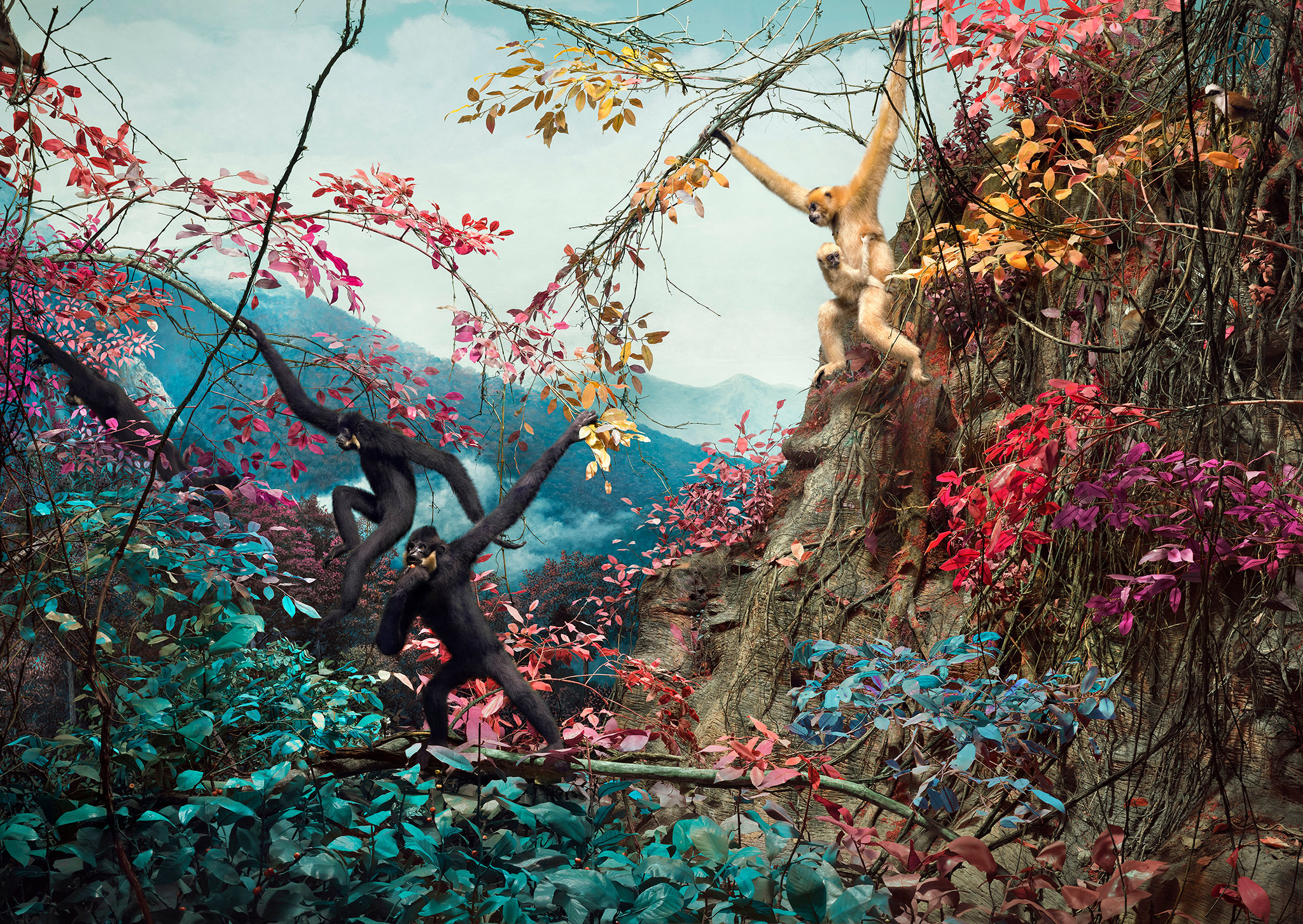
Pivovarchuk: You preempted me a little bit. You have said that a lot of your work “deals with historical subject matter and attempts to make connections with the past or reanimate history in some capacity.” Projects such as “Animal Kingdom,” “Re-enactors” and “Mountains of Kong” definitely follow this line. But “Eremozoic” has a very different feel, like you are drawing on the past to make a very strong comment about our future. The use of the pink color scheme is such a striking message — this was deliberate, wasn’t it?
Naughten: Well, in a way, it’s trying to create a fantasy world, trying to make a fiction. The reds are quite alarming. It’s interesting, because once the work’s in on the wall, it starts taking on a life of its own and people start interpreting the images in different ways, which I think is fantastic. That’s when art starts working quite well and functioning. I’ve had people say that they think the pictures are absolutely beautiful and joyful — and I am thinking, Ooh, well… And other people say that they find them really disquieting and almost a little bit unnerving. In a way, that’s fantastic, because you have the gamut of different responses and people thinking about the work differently.
But the original idea with the colors is to make them very eye-catching. What you are looking at is a fiction, even before I’ve altered it and colored it, adding layers of fiction on top. So we have a fictionalized view of the natural world, which is in incredible trouble, really. The extinction rate is extraordinary. This hasn’t happened since the dinosaurs were wiped out, 66 million years ago. This is the first time in the 542 million years of life on Earth that a single species has been annihilating all the other ones. It’s never happened before.
There is another fiction, the fact is that there’s a disconnection from the natural world. Obviously, I’m a modern human, so I’ve never been connected. I feel a sense of loss learning about our ancestors and how connected they were to the natural world. I think a lot of people feel that there is something slightly easy about where we’re going. And this fiction that we are disconnected is another one, in a sense that we are actually still part of the natural world, we are primates, we are subject to the rules of nature, and we are also susceptible to things like viruses, for example.
The other idea for the work is to think about how we are disconnected from it, how we regard it and put it in a kind of box — natural history happens over there, you only see it on TV or in a zoo; this is our world, and natural history is a little pocket of it.
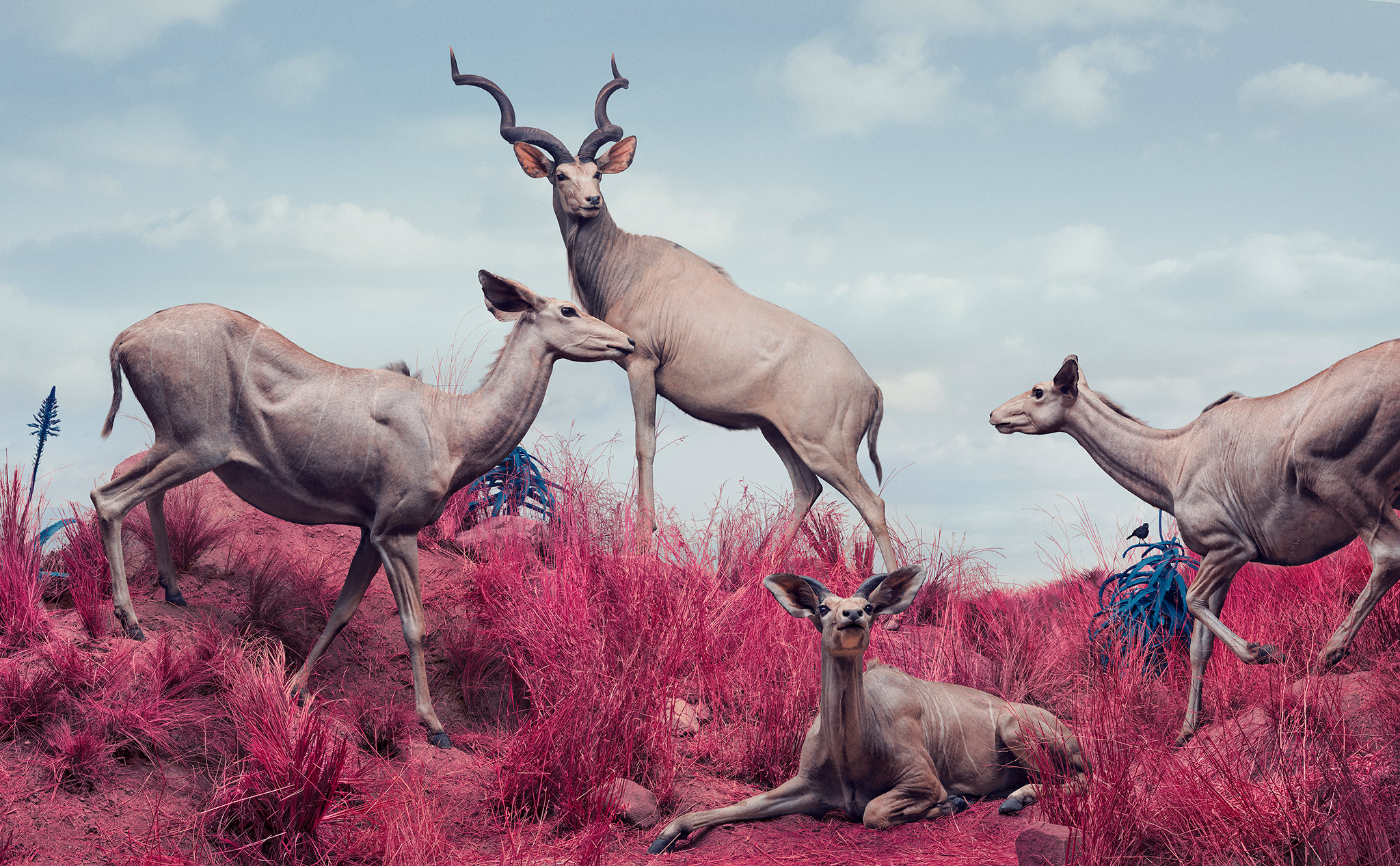
Pivovarchuk: Before we dig deeper into the environmental angle, I wanted to ask you about your process. You started out as a painter, only later warming to photography. Could you explain your process of creating these images? What is the hardest bit? Because they are so intricate, so deep and real — and surreal at the same time. How long does it take to make one?
Naughten: So the natural history dioramas are from the late 1800s and through to the early 1900s. They are really beautifully made. Originally, they look incredible. What I do is I photograph them with very, very high-resolution camera. Some of them are made up of elements, so I’ll add skies or move elements around; other ones are just the case of altering the colors. But that’s very, very detailed. It’s usually a very long process. Working out with which colors work can be a very long process.
Some of them work very, very quickly, almost instantly, and then others can take months. “The Kudus” or “The Orangutans” both have 14 or 15 different incarnations as different colors, differently arranged. They just go on and on and on, like an oil painting.
It’s quite tough. I really miss paint and I’m desperate to go back to it. But there is something you can do with photography — and PhotoShop — if you do it well. I think these images work.
Pivovarchuk: Let’s get back to the heart of the matter here. You care very deeply about the environment. For instance, I know that you are a committed vegan, which is quite a commitment in itself. These themes are clearly close to your heart. What role do you think art can play in alerting people to the climate issue? Do you think artists are doing enough? Should they be doing more? Is it art for art’s sake, or art as activism, or something in between? Where do you see yourself on that spectrum?
Naughten: It’s really difficult to say. There probably is a lot of art on climate, less so on biodiversity loss. I’m a little bit worried I am in an echo chamber along with Greta and the kids, but it feels like there is a groundswell of people beginning to wake up to the situation. I am sure there will be more art created along the themes of biodiversity loss. I haven’t seen huge amounts. It’s good with this project that it’s caught attention and it’s engaging and hasn’t sent people the other way. I just hope that I get the message across.
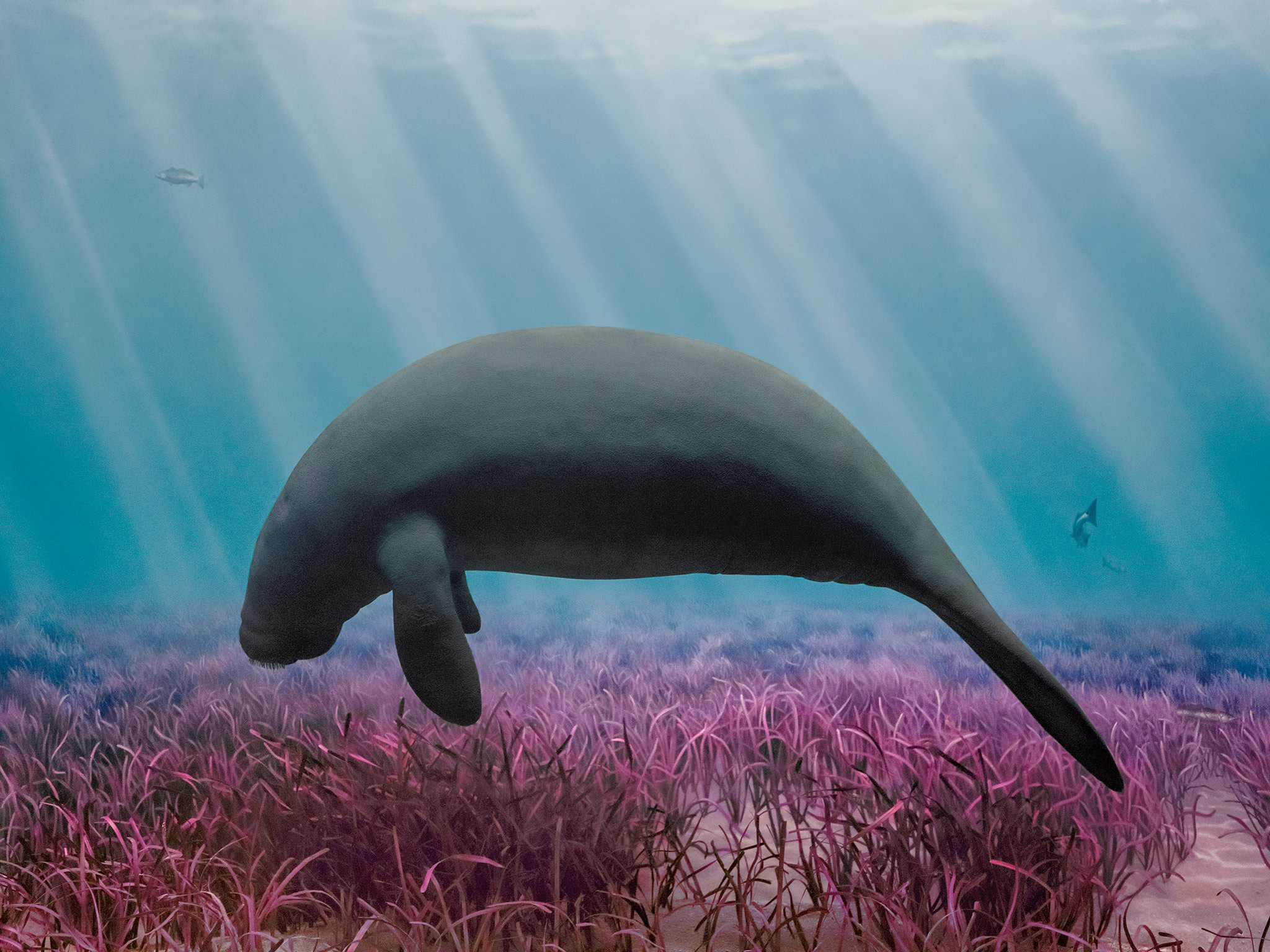
And it’s not difficult being a vegan — I don’t see it as a sacrifice. The food is absolutely amazing. Once you start cooking, it’s a different mindset. It’s just wonderful.
Pivovarchuk: We have just had the first Earthshot Prize awarded by the duke and duchess of Cambridge. How do you feel about such events? Are they a good way to raise awareness of the issue, or is it just glitz and no action?
Naughten: That’s a good question. I find that if I read The Guardian too much, it just gets incredibly depressing, and I can be overwhelmed with the “ecogrief,” I think it’s called. What’s infuriating is that we know what to do, we know how to fix the planet, but we are trapped in these incredibly complex systems. I would say the financial sector driving fossil fuels and Xi Jinping not coming to COP26, for example — it’s just insane. It can get so overwhelming.
Something like the Earthshot Prize: I really enjoyed watching it, even though I am not a royalist. It’s just that you have to have some hope, and you have to have some positivity. So for me, even though it’s got the dramatic BBC music at the end and it seems a little bit overblown, it is really important to keep spirits up and to keep hope going. I think that’s critical.
There’s another person who does that for me: Jane Goodall. She’s incredible. She has a podcast called Hopecast. She’s absolutely fantastic. She’s got a book called “The Book of Hope.” She talks a lot about how important a sense of — I don’t know if spirituality is the right word, or a kind of a love — she’s worried about science when it’s too cold. I think that’s a really interesting idea. I love listening to her, and that gives me some hope.
Pivovarchuk: I wanted to ask you about other projects, the Hereros, a Namibian tribe that developed a sartorial tradition of dressing in Victorian-era garments and military uniforms. Again, the images are absolutely beautiful, striking and stark. Obviously, the subjects have made the garments their own, but you cannot unspool the colonial influence there. What is your connection to these images? Why did you find this [tradition] particularly interesting? What do they tell us about our history of colonialism and the way it is still around us these days?
Naughten: The clothing is extraordinary, and what is so interesting about it is the clash of cultures that happened around 1895 when the German missionaries first arrived in Namibia. They first met the Herero tribe, and they obviously tried to Christianize them. They wore animal skins — they looked incredible before they got the Victorian costumes.
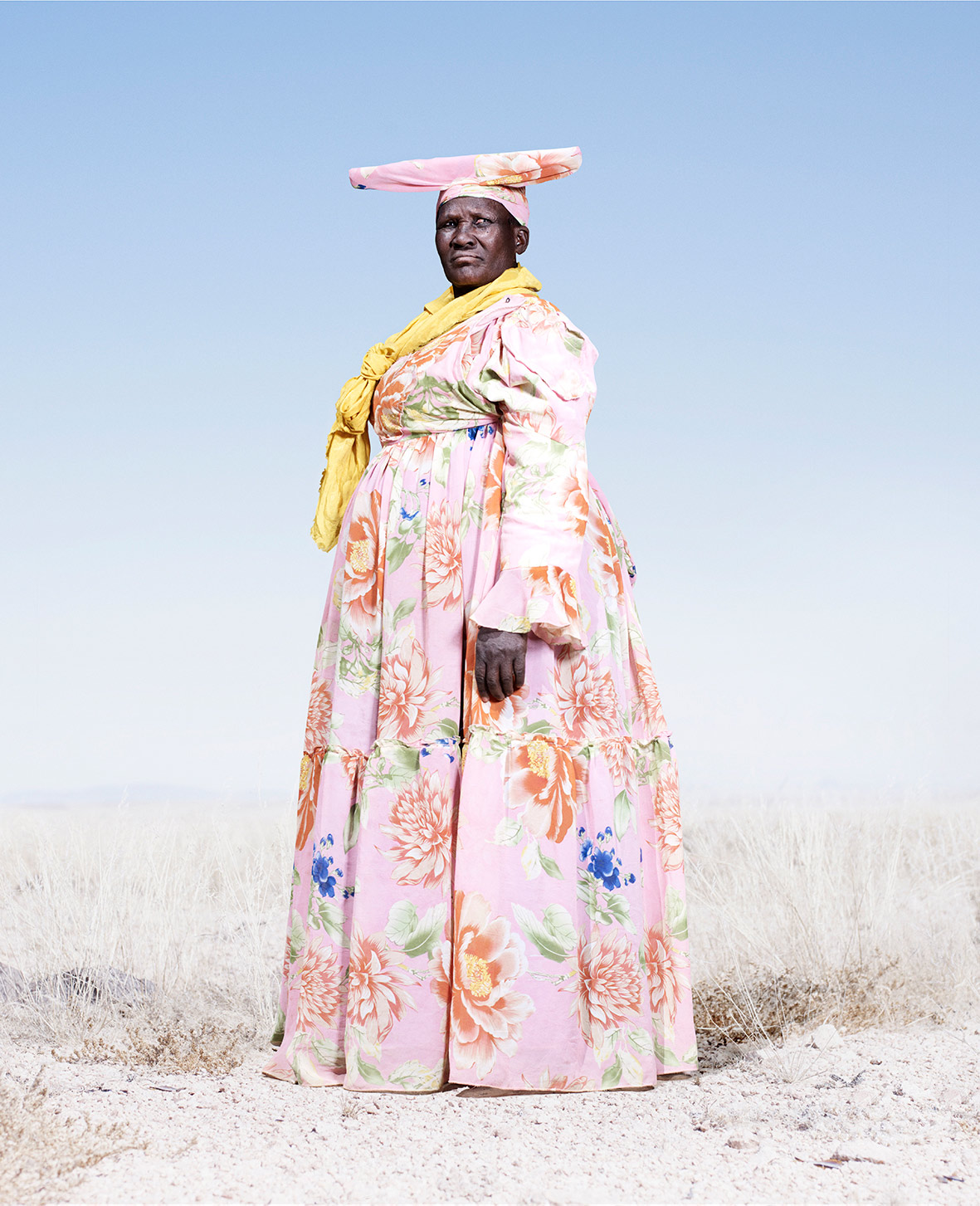
Because the history isn’t really written about what happened in the early days, no one quite knows whether they took to them originally or if there was a certain amount of coercion; I’m sure there’s a combination. But now, it is an incredibly important symbolic thing to wear the dress. What they added over the years is the African color and made them their own.
Because they are cattle herders, they are pastoralists, they are completely obsessed with cattle. So the headdresses represent cow horns. It’s quite extraordinary that they would walk or glide, and you’re not supposed to see the feet — they are supposed to almost represent the way a cow moves. They do a cow dance. It’s just a very strange thing.
What happened in 1907 is that the Germans decided they would then take all the land for themselves — it’s a lot more complicated than that — but the Herero fought back and the Germans decided that they would try to annihilate the whole tribe, basically committing the first genocide of the last century.
So the dresses are extraordinary as symbols of survival and defiance. If you see a Herero, you know they are a Herero and you know they survived, you know they’re here. Eighty percent of the tribe were killed in really horrific ways. It’s amazing to see them walk around in these costumes — they are so bold, and you see them set against the desert background.
During the Herero-German wars, if a Herero killed a German soldier, he would take the uniform and wear bits of it, like the helmets, the jackets and boots, so they’d have these very strange, cobbled-together outfit. What that meant was that it was taking the spirit of the German soldier and taking the power from the German soldier, and that was symbolic of having subsumed the power.
That also stuck as a kind of tradition. The Herero have a symbolic army, which is called the paramilitary because it doesn’t actually fight, but it’s there to honor the ancestors. They have a fire that goes all the time, the smoke goes up and connects them to the ancestors, so there’s always a direct line, and the people who were killed are still there.

Pivovarchuk: There is an exhibition that has just opened at Somerset House, called “We Are History,” that draws the origins of climate change to colonialism, to the Industrial Revolution and the extrapolation of resources. How do you think colonialism ties to the present climate catastrophe that we find ourselves in? Is it a reflection of how little humans care about the world?
Naughten: Oh, that’s a difficult question. As the Industrial Revolution started to take hold, it’s just one of these things, like a runaway train. People are constantly looking further and further afield for more land to exploit, more opportunities to exploit, especially when they are going to Africa. It continues. It feels now, with hindsight, that it was inevitable that it would happen once the ball starts rolling.
I’m really interested in our evolutionary history and how we got to where we got to. Homo sapiens is really, really, really young — we are 200,000 years old, a blink of an eye. During these 200,000 years, for 99% of it, we were hunter-gatherers, we were foragers and we existed in small bands. We were directly connected to the natural world, we didn’t have a monotheist god, we were completely egalitarian — men, women, children. This idea that humans are more important than animals is a modern idea. You could be slightly rose-tinted about it, but it was a fundamentally different existence from the one we have now.
That changed very recently, 10,000 years ago, with the agricultural revolution. We were, they think, between 6 and 10 million humans on the planet at that point, and what we are now, since we started farming, we are 8 billion. We’ve exploded, exponentially, like a huge mushroom cloud all over the planet, and we are just taking all the resources. Before we were farming, we were living very, very, very, very lightly on the land, and had we not started farming, we would continue in this way for as long as the planet would allow us to. We certainly wouldn’t have climate change.
Before the agricultural revolution, humans made up less than a percentage point of all the mammals on the planet. The remaining 99.5% were wild animals. Fast forward 10,000 years, the tiniest amount of time in evolutionary terms: Humans now make up 36% of the mammals on the planet, our livestock, our caged, brutalized animals, make up 70%, and wildlife makes up 4%. And it’s reducing, very quickly. It’s just completely insane.
Yuval Noah Harari, who wrote “Sapiens,” [“Sapiens: A Brief History of Humankind”], who is an incredibly clear thinker and is extraordinary to read, says that industrial farming of animals, in terms of pain and misery caused, is definitely humanity’s greatest crime. I think that’s true.
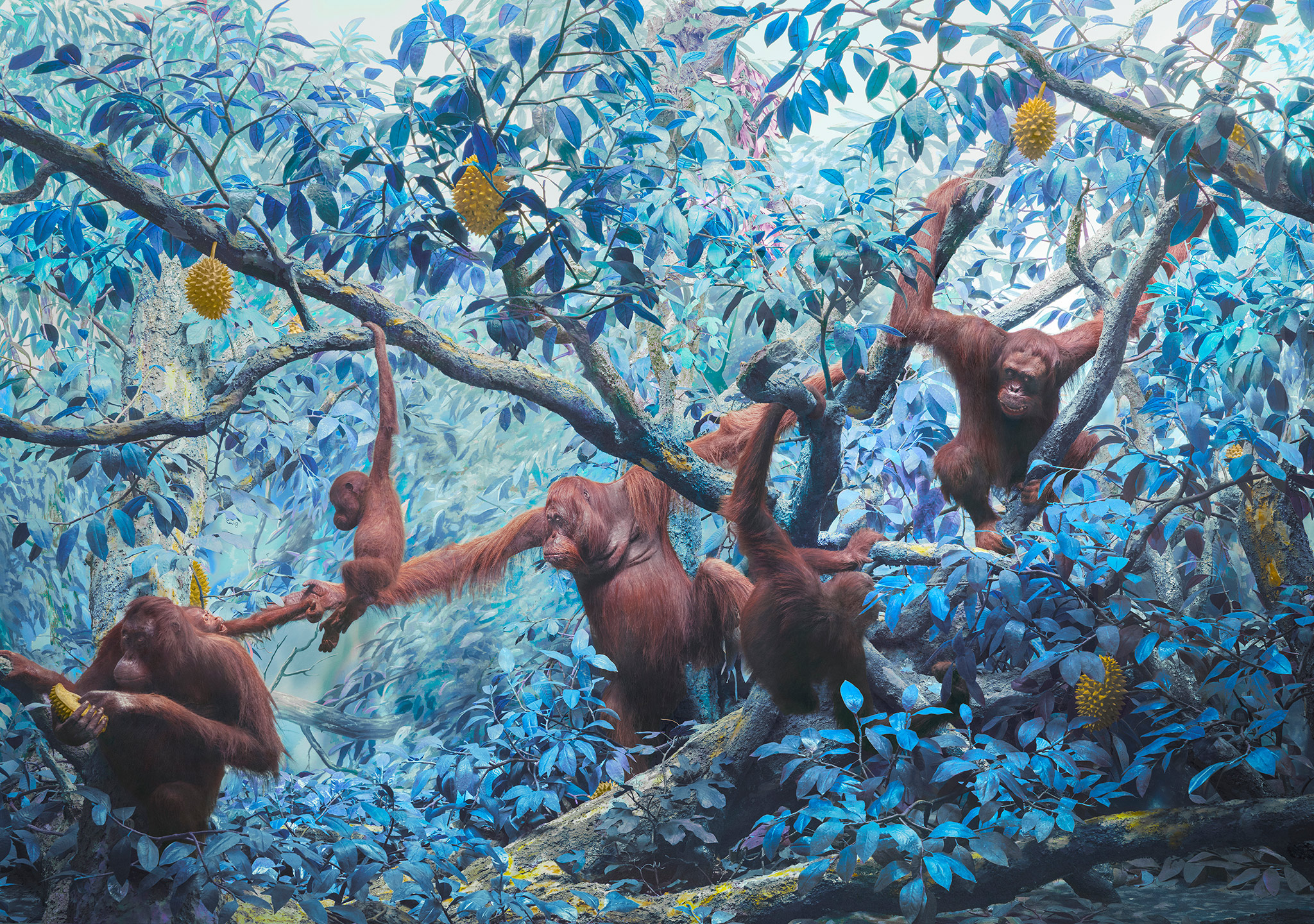
Pivovarchuk: To come back to hope. Your show opens in the same month as COP26 in Glasgow. Are you hopeful about our planet’s future? What’s going to happen to us?
Naughten: I think like everyone, probably nervous, very nervous. And you hear different points of view that people say it’s a mess, it’s not going to happen. It’s very difficult to have any faith in Boris or any of the leaders there — they all just seem utterly useless. I don’t know the answer to that to be honest.
I was thinking about the situation with how damaging the meat industry is to the planet, and that is one thing that is very difficult to get into the media, for example, or the politicians to talk about. They don’t want to talk about meat because they eat meat. It’s such an unpopular thing to say, even if it’s one of the biggest drivers of climate change, habitat loss. Even when you’re talking to zoologists or ecologists, they might eat meat and they can’t say, Don’t eat meat. So I think we are sort of, pardon the pun, hamstrung a little bit.
I’m an artist, I’m not an expert on these things. I don’t think anyone knows how this is going to go. I’m fearful, I’m nervous, I’m hopeful — I think I got all kinds of emotions. Biden seems to be very encouraging; he seems to be making the right noises. You read something, and you think, Ooh, there’s hope, and then you read something else and you think, Oh my god, this is horrific. So yes, it’s a cliché, but it’s a rollercoaster.
I secretly hope that China is taking it more seriously. Wishful thinking: maybe China is understanding it. But at the same time, idiotically, they are investing in coal, and you think, Oh, come on, you can’t have it both ways. They perhaps understand the problem, they want to address the problem, but they also want to be in the lead.
As you find in “Sapiens,” he talks about the fact that these enormous problems facing the world are global problems, and it’s incredibly difficult because you have these different nation-states with different ideas who want to be in charge of the other ones. I don’t know. We’ll see. What do you think?
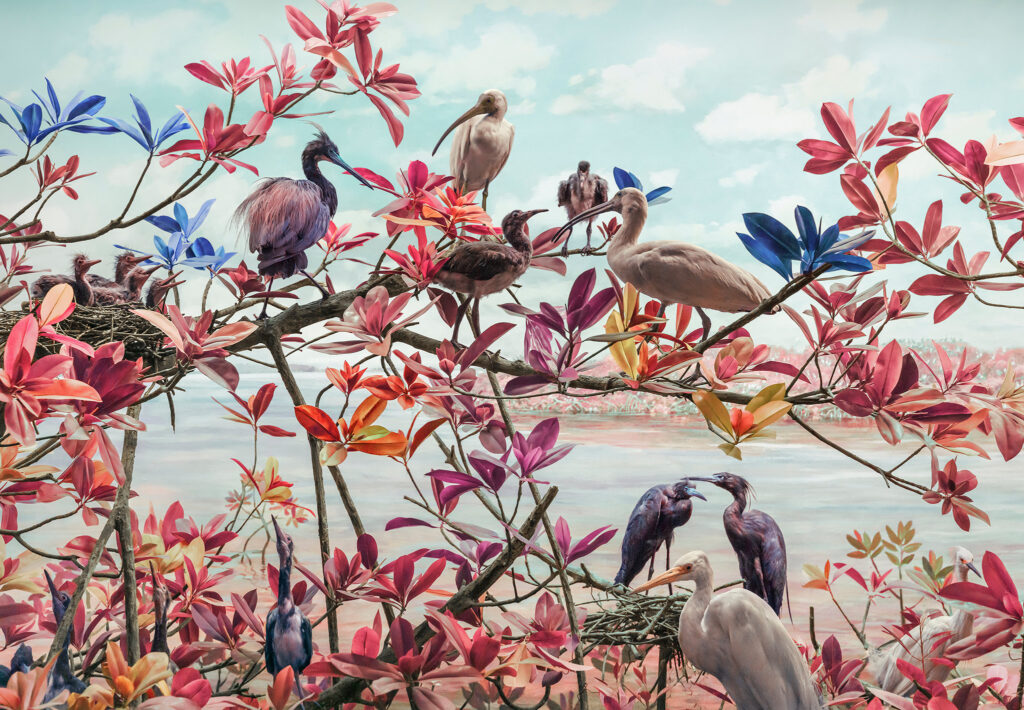
Pivovarchuk: I do have a lot of hope in the young generation. I think they are incredible.
Naughten: Yeah, I went on Extinction Rebellion marches and I went on the school strike [Fridays for Future], which was great. I got there and it’s just thousands and thousands of kids, walking up to Parliament Square, and there was a lump in your throat. I started welling up when I got there — it was really emotional. It does give you some hope, which is really important. Hopefully, the kids are a bit more woken up. My godson, he’s great. He’s 21, he’s such a force for conservation. We talk a lot. So yeah, I’m kind of hopeful — you have to be, really.
*[“Eremozoic” is on at Grove Square Galleries until November 18. The show is supported by Fauna & Flora International; 10% of all proceeds from the show will go to FFI.]
The views expressed in this article are the author’s own and do not necessarily reflect Fair Observer’s editorial policy.
Support Fair Observer
We rely on your support for our independence, diversity and quality.
For more than 10 years, Fair Observer has been free, fair and independent. No billionaire owns us, no advertisers control us. We are a reader-supported nonprofit. Unlike many other publications, we keep our content free for readers regardless of where they live or whether they can afford to pay. We have no paywalls and no ads.
In the post-truth era of fake news, echo chambers and filter bubbles, we publish a plurality of perspectives from around the world. Anyone can publish with us, but everyone goes through a rigorous editorial process. So, you get fact-checked, well-reasoned content instead of noise.
We publish 2,500+ voices from 90+ countries. We also conduct education and training programs
on subjects ranging from digital media and journalism to writing and critical thinking. This
doesn’t come cheap. Servers, editors, trainers and web developers cost
money.
Please consider supporting us on a regular basis as a recurring donor or a
sustaining member.
Will you support FO’s journalism?
We rely on your support for our independence, diversity and quality.




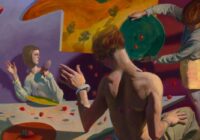



Comment